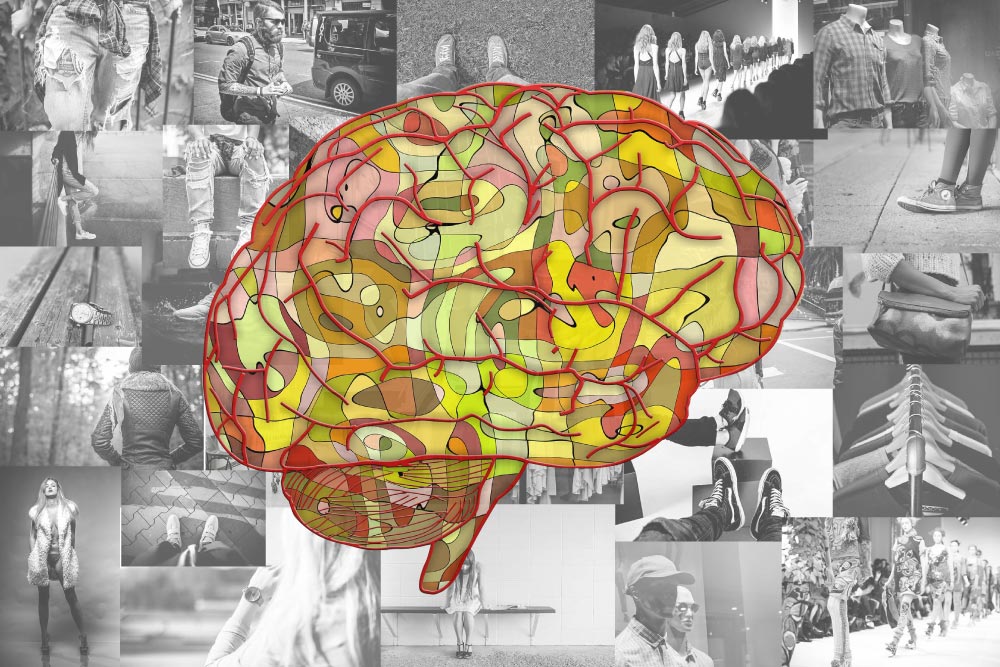Doped Up on Style: How Fast Fashion Triggers the Human Psyche

Shirts for $5. A dress for $14.99. Jeans for under $20. You go out with enough money for a dinner, but instead, you can revamp your wardrobe for the same amount. Next week, you can do the same thing, since the clothes you just bought are now out of style, but it’s OK: you got your full three wears out of them.
Fast fashion: trendy, stylish, and most of all, cheap. Sure, the quality isn’t great, but does that really matter when you only need it for a week or two until the next trend comes along? How bad can it be?
Well, until the 1980s and 1990s, not too bad, actually.

Jackets
Fashion has come a long way. From tailored garments made entirely by hand to the frenzied production we know today, fast fashion is merely the result of decades of manufacturing advancement, and it all began with the introduction of ready-made clothing. Ready-to-wear garments were made in a pre-determined range of sizes, which made manufacturing much more efficient, so much so that by 1915, the textile industry was the third largest in the United States, after steel and oil. This first “acceleration” was the first big change that would lead to the evolution of fast fashion as we know it today.
The second “acceleration” began during and after the Second World War. Because of fabric and material restrictions, there was an introduction of more functional designs and styles, which led to a sharp increase in the standardization of apparel manufacturing. This standardization led to a dramatic increase in the speed of production, in a way that had never been seen before, which in turn drove prices down significantly. By the 1960s, people were beginning to really embrace cheap clothing, not to mention making a bigger effort to follow current trends.
We need to remember that, at its core, fast fashion (at least in its infancy) was actually a pretty great thing. Firstly, and more obviously, it was indicative of industrial and technological progress. More importantly, however, was its socio-economic reach. Cheap but stylish clothing meant that more people, regardless of their social or economic backgrounds, were buying the same clothing. In the past, style (and fashion in general) was a luxury afforded only to those with the means to pay for quality fabrics, seamstresses, and tailors. But by the mid-twentieth century, that was no longer the case: standardization and speed of production created a democratization of fashion.
Until the 1980s, the fashion calendar consisted of a basic pattern coordinated by the seasons: Spring/Summer and Autumn/Winter. However, by the 1990s, a third acceleration was in the horizon. It would completely change the industry, condense numerous micro-seasons in a year and reshape the fashion business model entirely. It would define the term ‘fast fashion’ as we know it today: fast, cheap, and ultimately disposable.
From the mid-1990s onward, the runways, fashion shows and catwalks became a worldwide public phenomenon. People were following fashion like never before: with magazines and the Internet, they had access to fashion shows that were previously only available to a select few in the fashion and publishing industries. Not only that, the exposure was in real time. By seeing new designs sooner, people wanted the new styles for themselves sooner.
 East Meets West' IFA Fashion Show in Paris
East Meets West' IFA Fashion Show in Paris
This unprecedented accessibility to new designs and styles created a larger, more immediate demand, which forced suppliers to produce clothing with a reduced lead time, marking the official “birth” of fast fashion. It became ‘fast fashion’ as we know it today: fast produced, low quality, cheap clothes that will be stylish for about a week. Manufacturers changed their entire business models in order to cope with the new pace of the industry: they went from trying to predict trends — which can be very risky — to merely adapting styles directly from the runway. Retailers like Zara have perfected this model to such efficiency that they can churn out about 12,000 new designs per year!
This model became a catalyst for another side of humanity, preying upon its fickle nature and insatiable desire for instant gratification. It destroyed fast fashion’s initial neutral (if not progressive) meaning, sending a message of excess and transience instead. Quality and permanence have no place in this new industry: the point is to sell cheap and to sell a lot.
It’s really no mystery why this unsustainable model has thrived. We are wired to find pleasure in the pursuit of inexpensive things; shopping has become a relatively cheap form of entertainment. It’s a neurological process: different areas of our brain are engaged when we are exposed to things we like and how much we want them. Fast fashion today has been specifically engineered to take advantage of human psychology.
Fast fashion retailers know how to manipulate the human psyche. Items we desperately want are dirt cheap, which makes them very easy to buy. This is an incredibly manipulative move: our brains respond with joy over something we want and pain over how much it costs. So, by selling incredibly cheap clothing, retailers are making us very happy with both our options and their prices. This makes consumption almost mindless, since we can only see the benefits of cheap and stylish clothing.

Sale
The insane pace and manipulative ideals are the root of the industry’s many problems. Media, marketing, and publishing tell us what we want and when we want it, and retailers take advantage of the human psyche to feed into the vicious cycle that fast fashion has become: buy, wear, trash, repeat, with an alarming frequency. Our obsession with this unsustainable model has mutated into an addiction, a disease that puts trends over truth and allows us to follow them blindly, even when human lives are destroyed in the frenzy. An industry that began as progress has evolved into a plague.
But it doesn’t have to be like that. Some of us have seen the damage, and have come to realize that fast fashion has become completely unsustainable. Every day, new ‘slow-fashion’ blogs (such as Slow Fashioned) and brands (such as Toad and Co.) surface, bringing with them a renewed passion for the good in fashion, by designing and creating garments with a focus on quality and longevity.
We have the power to redefine fast fashion and give it a new meaning; one that mirrors a better side of our humanity: the creative, inspirational, progressive side. We can keep the style, the creativity, the longing for inspiration, without resorting to the dark side of fast fashion. We have evolved this far; maybe it’s time to look back and evolve sustainably.

Leave a comment